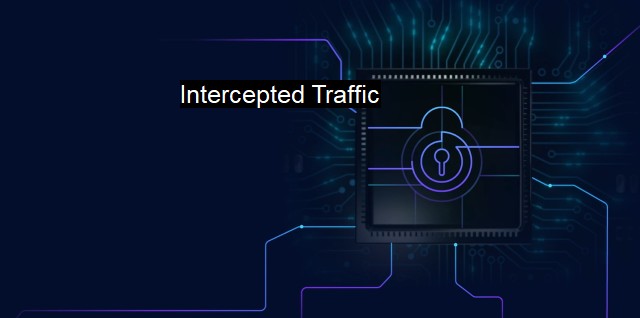What is Intercepted Traffic?
Intercepted Traffic: Addressing the Persistent Threat to Cybersecurity in a Digital World
Intercepted traffic is a crucial term in the cybersecurity industry, referring to the act of catching, analyzing or even modifying the information being exchanged between two entities on a network. While the concept itself is fairly neutral and can be utilized in various ways for different purposes, in the context of cybersecurity and antivirus systems, it generally carries more of a threatening connotation.Intercepted traffic is a key tool for cybercriminals who aim to gain unauthorized access or control to an entity's sensitive data. Through intercepting the information packet that travels through the network from the sender to a receiver, these adversaries manage to access that data during the transit, essentially resulting in a breach that affects the integrity, confidentiality, and availability of information. Common examples of this method include Man-in-the-Middle (MitM) attacks or eavesdropping, where an attacker interposes himself between two unsuspecting parties and diverts the trajectory of the data exchange.
One key characteristic of intercepted traffic is its subtlety. The interception often goes undetected until a noticeable disruption or unmitigated damage occurs. This is because, in many instances, the hacker adjusts the intercepted data slightly before sending it to its original destination, making it appear as if the information exchange process is proceeding as normal. It makes the interception act stealthier, increasing its overall damage potential by allowing the cybercriminals more time to perform actions like identity theft, financial fraud, or espionage.
Antivirus systems and cybersecurity strategists are always racing against cybercriminals to bypass the challenge of intercepted traffic. The primary goal hintering cybersecurity is the protection of information and systems from any potential threats or disruptions, which includes detecting and neutralizing any attempts to intercept network traffic.
One notable method is the use of strong encryption algorithms. Encryption converts the original information into an unreadable format for anyone that does not possess the secret key, protecting the data even if it is intercepted during the transition. HTTPS and SSL/TLS are common encryption technologies used to make data unreadable to unauthorized parties.
Data encryption alone is not completely immune to traffic interception, since proficient hackers possessing enough resources could potentially break this layer of security. A multi-layered security approach is necessary to limit the nefarious acts of hackers. This could involve a host of additional solutions including intrusion detection systems (IDS), intrusion prevention systems (IPS), firewall strategies, and practicing secure coding techniques.
IDS and IPS can detect and deal with suspicious behaviors or unauthorized network system changes. These systems diligently monitor network traffic, immediately alerting the organization about potential interception attempts and blocking them. Similarly, correctly configured firewalls could mitigate many common types of interception attempts by defending the network with a protective shield between a trusted and an untrusted network.
Despite these security measures, the human element should never be neglected. Phishing is widely recognized as a simple method to cause damage since it exploits human psychology, playing a critical role in numerous interception attempts. Thus, it’s paramount to educate and tra users on safe online behaviors and how to identify potential risks.
Intercepted traffic is a matter of grave concern providing malicious actors with undue access to sensitive data. It necessitates the integration of robust, technologically advanced strategies within antivirus systems to detect, prevent, and react to these attempts. it's equally vital that the human element is not overlooked in these strategies, with proper emphasis on cybersecurity education and information literacy.

Intercepted Traffic FAQs
What is intercepted traffic in the context of cybersecurity and antivirus?
Intercepted traffic refers to the data that is captured and analyzed by security systems or antivirus software before it reaches its destination. It is a technique used to prevent cyber threats by monitoring the traffic passing through a network.What are the benefits of intercepting network traffic for cybersecurity purposes?
Intercepting network traffic provides several benefits for cybersecurity. It allows security systems to detect and prevent cyber attacks before they reach their target, provides valuable insight into potential vulnerabilities in a network, and helps security professionals to identify and mitigate security risks.What tools are used to intercept network traffic in cybersecurity and antivirus?
There are several tools used to intercept network traffic in cybersecurity and antivirus, including intrusion detection systems (IDS), intrusion prevention systems (IPS), firewalls, and antivirus software. These tools work together to monitor and analyze traffic passing through a network, blocking potential threats and identifying vulnerabilities.Can intercepted traffic be decrypted and compromised?
Intercepted traffic can be decrypted and compromised, especially if it is not protected by encryption. However, the use of encryption protocols like SSL/TLS can make it difficult for attackers to decipher intercepted traffic. It is important to ensure that all sensitive data transmitted over a network is encrypted to prevent interception by cybercriminals.| | A | | | B | | | C | | | D | | | E | | | F | | | G | | | H | | | I | | | J | | | K | | | L | | | M | |
| | N | | | O | | | P | | | Q | | | R | | | S | | | T | | | U | | | V | | | W | | | X | | | Y | | | Z | |
| | 1 | | | 2 | | | 3 | | | 4 | | | 7 | | | 8 | | |||||||